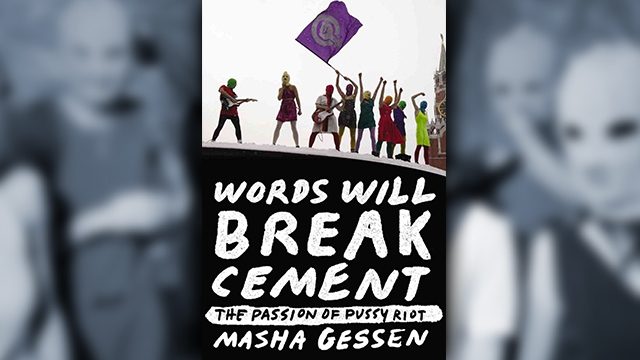SUMMARY
This is AI generated summarization, which may have errors. For context, always refer to the full article.
 It’s early in the day of February 21, 2012 and 5 women in neon-bright dresses, stockings, and pastel balaclavas are practicing a protest song in an undisclosed location.
It’s early in the day of February 21, 2012 and 5 women in neon-bright dresses, stockings, and pastel balaclavas are practicing a protest song in an undisclosed location.
It’s a punk song with loud verses, distorted guitars, and a lilting chorus not unlike a hymn that petitioned: “Virgin Mary, Mother of God, chase Putin out.”
They’ve pre-recorded the riffs and music so the guitars are really just for show. By the end of the day they had crashed the gates of Moscow’s Cathedral of Christ the Savior and performed up on the dais, the area nearest the altar and had been stopped by church security as well as some of the church goers.

The same evening, they had turned footage of the performance into a music video titled “Punk Prayer: Mother of God, Chase Putin Away!” and posted it online.
The next morning the video had gone viral and was on almost every news outlet in Russia and Europe. A few days later it had reached America and Asia, and the group Pussy Riot was famous, celebrated – it was also wanted by Russian authorities.
The description in the video stated that the women of Pussy Riot acted the performance in protest against the vulgar show of the Orthodox Church leader’s support for Putin during his election campaign.
By the first week of March, three of the five girls on the video had been arrested. A week later the world exploded with support in reaction to their incarceration, including a scrawl on Madonna’s back during a concert in Moscow, and a Peaches song.
Looking back
What do I know of Russia in 2012? That Putin had been handed back the Presidency from his buddy Medvedev; that three women got arrested for performing inside that cathedral; and feminist punk in Russia just gained a quantum leap in fame and perspective.
This is the arc and coverage of Words Will Break Cement by Masha Gessen (also the author of the anti-Putin biography The Man Without a Face), who narrates the story of Pussy Riot from its gestation in the performance art collective Voina, up to the first versions of the band (called Wee Wee Riot), honing shock performance as Pussy Riot, jail time, a show trial, and more jail time.
A few things to remember while reading Gessen’s work or even watching the 2013 documentary by HBO Pussy Riot –A Punk Prayer.
- Pussy Riot is not just composed of Nadezhda Tolokonnikova (Nadya), Yekaterina Samutsevich (Kat), and Maria Alyokhina (Masha in the HBO docu), the three girls who were arrested and later gained international media attention. The collective has a variable membership of around 11 women, including some men (like Nadya’s husband Petya, or Peter).
- Although they describe themselves as a feminist punk band, Pussy Riot isn’t an actual band, nor are the members (at least none of the three girls were) actual musicians. They just play a fictional band, like the embodiment of an idea, to “perform” political protests through music and metaphor. The women in balaclavas are thus rendered as characters and their motto: Anyone can be Pussy Riot, is emboldened by this symbolism of anonymity.
Gessen’s work delves deeper into the histories of the three girls who were imprisoned, through exclusive letters and interactions she got from Nadya, Kat, and Maria (but mostly Kat and Maria) while in jail, and through interviews with the rest of the Riot members, their families, and their friends.
While the HBO documentary presents a vivid albeit quick portrait of how Pussy Riot came together, Gessen works on her own mural and traces how the quirky art group Voina and its members were eventually left dissatisfied with the shocking, albeit fairly shallow and obscurantist methods of that collective, like kissing cops and holding an orgy at a biology museum.
This of course eventually led to the formation of the punk “band” that made pointed artsy, insta-performances in public places with distorted riffs and anti-administration lyrics for a more immediate, less tangential, and arguably tighter kind of show to get their message across.
Acts of courage
Like I said, they aren’t really musicians in the sense that they would have used any other creative means that would best carry their opinions and beliefs across (hence the visual symbology for anonymity – hence inclusiveness – of the bright neon/pastel balaclavas, stockings, and dresses accompanying the music), but they ARE punks in that their playing expressed two middle fingers, really fast riffs, and often the deficiency of actual musical skill that has come to be associated with the genre.
That a collective of women has embraced the punk aesthetic and used it as both weapon and fuel for protest because there is nothing of creative dissent in contemporary Russian culture just bowls me over. It’s an astounding act of courage. Makes you appreciate a democracy where you can sing and march in protest without getting sent to a gulag the day after.
Gessen’s work is nuanced, layered, and complex, just like the context that birthed Pussy Riot. It’s also rambling and often prone to muse on branching stories that weigh down the action of the narrative. Boy, you can really feel the boredom of the girls in jail and those parts I could have really skipped over.
Here though I must draw a parallel to the Taqwacore movement in North America, where a loose collection of Muslim musicians were inspired by a book to form real punk and bands and eventually culminated in a tour across the USA.
Like the Taqwacores, Pussy Riot concluded that “punk” was a blank canvas – an empty banner with which to rally those who share the same idea – and an umbrella to huddle under as you paint the aegis of refusal to do battle in the realm of ideas.
It may look violent, it may sound harsh, but punk endorses a peaceful revolution of the mind. Three minutes to change the world and your stompbox as spiritual armor, enacted via metaphor, powered with courage, and a one-two-three-fo’!
From a music critique standpoint, Pussy Riot’s repertoire of subjects were pretty limited, with lyrical themes that never strayed out of Russian feminism, LGBT rights, and their fave pet topic: opposition to the policies of Russian President Vladimir Putin.
As a piece of local culture, they were novel but they said nothing new in the greater history of punk rabble rousing that The Clash or Bad Religion haven’t already gone over.
It’s also of interest to note that Gessen is a Russian lesbian who moved to the US with her partner and their children because of the anti-gay laws in Russia.
Where it shines
Pussy Riot has used punk to re-imagine a better Russia, and to endeavor to shape their world without demagogues, cultural rot, and political static. A Russia free from Putin. Of course they got arrested and put through a show trial.
This is where Gessen’s work shines with revelation. Riot had, previously, already performed in a lingerie store, on a roof top, and in the Red Square near the Kremlin.
But it’s the cathedral gig that really got the government’s and the Orthodox churchgoers’ goat.
Their accomplishment can’t be overlooked at all, however. With the cathedral performance, jail time, and the coverage of the trial, Pussy Riot has done more to shine a light on Russian life’s ills and corruption than any news agency has in years.
With the Taqwacore movement in America and Pussy Riot in Russia, punk rock has unexpectedly become the empowering force it’s long hankered for, the dreamer who can almost literally enact change by shouting at the ills and social dystopia surrounding him.
To enact crisis and release static through attention was the impetus, a strategic consistency of shock; with the Pussy Riot performances the three jailed women and their comrades have made punk bigger than the system it’s trying to bring down, like a giant looking over its own shoulder.
Gessen’s work is at its best when she simply recounts action and leaves herself out of the narrative (which happens more often than a reportage/biography book should normally allow).
This happens in the prison scenes, the lull during the trials and at transfers, and in the communiques between Nadya, Maria, Kat and their friends and loved ones. All these in-betweens happen off-camera, without a camfone or journalist to record the event.
Where it stumbles
It is, sadly or likely with forethought, Gessen herself who trips up her own writing when she shows her politics, coloring her reportage and her narrative powers and often surprising the reader with such seething rage. At least it did for me, when I read parts like these: “Medvedev, a tiny man who looked like a cross between a third grader and his favourite stuffed toy, had been anointed Putin’s successor; the day after the action, he was elected to the office of president so he could keep the chair warm for Putin for four years.”
There’s a lot of these scattered throughout and though I applaud going gonzo, getting side tracked like this should go into another piece of work, not when you’ve already got access to your subjects no matter how limited.
All in all the book is at its core an entertaining documentation of Russian judiciary processes in reaction to what five women did at a cathedral, what it meant to Russian liberals, and what it meant to the world, and why it motivated musicians and celebrities to assemble support on social media and other methods.
The book stops while Maria and Nadya are still in prison, but the great epilogue off-book here is that, having served 21 months, Tolokonnikova and Alyokhina were released on December 23, 2013 after the State Duma approved their amnesty.
By early this year though, they were up to their old antics trying to perform a song at the Sochi Winter Olympics site. The Cossacks, atraditional and ultra-conservative militia, were also there to greet these punk women in their own fashion. Welcome back, Pussy Riot. – Rappler.com
Karl R. De Mesa is the author of the book of reportage Radiant Void, now available in major bookstores in Metro Manila
Add a comment
How does this make you feel?
There are no comments yet. Add your comment to start the conversation.